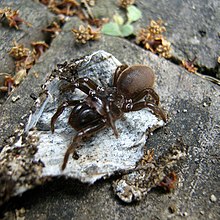| Atypus Temporal range:
| |
|---|---|

| |
| A. karschi | |
| Scientific classification | |
| Domain: | Eukaryota |
| Kingdom: | Animalia |
| Phylum: | Arthropoda |
| Subphylum: | Chelicerata |
| Class: | Arachnida |
| Order: | Araneae |
| Infraorder: | Mygalomorphae |
| Family: | Atypidae |
| Genus: | Atypus Latreille, 1804[1] |
| Type species | |
| A. piceus (Sulzer, 1776)
| |
| Species | |
|
33, see text | |
| Synonyms[1] | |
| |
Atypus, also called purseweb spiders, is a genus of atypical tarantulas first described by Pierre André Latreille in 1804.[3] It occurs in Eurasia, with one species (A. affinis) reaching into North Africa.[1] Only three of the described species occur in Europe: A. piceus, A. affinis, and A. muralis.[1] Specimens from the USA formerly known as A. snetsingeri represent an introduced population of A. karschi.[4]
Peasants in the southern Carpathian Mountains used to cut up tubes built by Atypus and cover wounds with the inner lining. It reportedly facilitated healing and even connected with the skin. This is believed to be due to antiseptic properties of spider silk (which is made of protein).[5] Atypus cobwebs have also been used in Sichuan and Tibet to manage the symptoms of diabetes.[6]
- ^ a b c d Cite error: The named reference
NMBEwas invoked but never defined (see the help page). - ^ Kraus, O.; Baur, H. (1974). "Die Atypidae der West-Paläarktis: Systematik, Verbreitung und Biologie (Arach. : Araneae)". Abhandlungen und Verhandlungen des Naturwissenschaftlichen Vereins in Hamburg. Neue Folge. 17: 88.
- ^ Latreille, P. A. (1804). "Tableau methodique des Insectes". Nouveau Dictionnaire d'Histoire Naturelle, Paris. 24: 129–295.
- ^ Cite error: The named reference
Řezáč et al. 2022was invoked but never defined (see the help page). - ^ Heimer, Stefan (1988). Wunderbare Welt der Spinnen (in German). Urania. p. 14. ISBN 3332002104.
- ^ Cite error: The named reference
:0was invoked but never defined (see the help page).